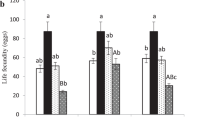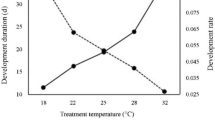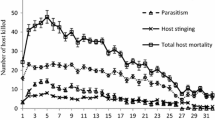Abstract
Comparisons of various strains of hymenopterous parasites,Muscidifurax raptor Girault & Sanders,M. uniraptor Kogan & Legner,M. zaraptor K. & L.,Spalangia cameroni Perkins,S. endius Walker,S. longepetiolata Boucek,S. nigra Latreille andSphegigaster sp. attackingMusca domestica L., showed that theSpalangia species consistently penetrated to the greatest depth, 4 cm, in an experimental wheat flakes habitat. Moisture influenced penetration behaviour of some species. Host destruction wrought by host-feeding and parasitization was often proportionally greater than progeny production at the lower depth, indicating that parasites searched there without finding conditions suitable for oviposition. Progeny production by all species was greater at the higher of 2 temperatures, 29 vs 21°C., but RH influenced parasitization and ♀♀ production, apparently according to strain preferences. Superiorily competitiveMuscidifurax species may be favored by comparatively cooler temperatures; this characteristic would account for their predominace in nature during cooler seasons. However, the problem of characterizing different species as to preference for certain strata of the host habitat and temperature is confounded with strain type, RH, habitat moisture and behavioral and developmental elements.
Résumé
La comparaison des divers genres d'espèces parasitoïdes,Muscidifuraz raptor Girault & Sanders,M. uniraptor Kogan & Legner,M. zaraptor K. & L.,Spalangia cameroni Perkins,S. endius Walker,S. longepetiolata Boucek,S. nigra Latreille etSphegigaster sp. attaquantMusca domestica L., a montré que l'espèceSpalangia a pénétré jusqu'à la plus grande profondeur, (4 cm) dans un habitat experimental de froment en flocons. La pénétration de quelques espèces a été influencée par l'humidité. Dans les régions plus profondes, la destruction de l'hôte et le parasitisme ont été souvent proportionnellement plus importants que la production de descendants, montrant que les parasitoïdes ont cherché sans les trouver des conditions favorables à la ponte. La production de descendants par toutes les espéces a été plus grande à la plus élevée des 2 températures: 29o et 21°C, mais l'humidité relative a influencé l'infestation par les parasites et la production des femelles, apparemment selon la préférence des lignées. Les espèces deMuscididurax, qui sont supérieures en concurrence, préférent peut-être les températures comparativement plus fraîches, ce qui expliquerait leur prédominance dans la nature pendant les saisons plus fraîches. Cependant, le probléme de la caractérisation des différentes espèces selon leur préférence pour certaines couches de l'habitat de l'hôte et pour la température est compliqué par le type de lignée, l'humidité relative de l'habitat et les caractères du comportement et du développement.
Similar content being viewed by others
References
Abbott, W.S. — 1925. A method of computing the effectiveness of an insecticide. —J. Econ. Entomol. 18, 265–267.
Ables, J.R. &Shepard, M. — 1974a. Hymenopterous parasitoids associated with poultry manure. —Environ. Entomol., 3, 884–886.
— — 1974b. Responses and competition of the parasitoidsSpalangia endius andMuscidifurax raptor [Hymenoptera: Pteromalidae] at different densities of house fly pupae. —Can. Entomol., 106, 825–830.
Ables, J.R. — 1976. Influence of temperature on oviposition by the parasitesSpalangia endius andMuscidifurax raptor. —Environ. Entomol., 5, 511–513.
Ables, J.R., Shepard, M. &Holman, J.R. — 1976. Development of parasitoids,Spalangia endius andMuscidifurax raptor in relation to constant and variable temperature: simulation and validation. —Environ. Entomol., 5, 329–332.
Bartlett, M.S. — 1947. The use of transformations. —Biometrics, 3, 39–52.
Kogan, M. &Legner, E.F. — 1970. A biosystematic revision of the genusMuscidifurax [Hymenoptera: Pteromalidae] with descriptions of four new species. —Can. Entomol., 102, 1268–1290.
Legner, E.F. — 1967a. Behavior changes the reproduction ofSpalangia cameroni, S. endius, Muscidifurax raptor andNasonia vitripennis [Hymenoptera: Pteromalidae] at increasing fly host densities, —Ann. Entomol. Soc. Am., 60, 819–826.
— — 1967b. Two exotic strains ofSpalangia drosophilae merit consideration in biological control ofHippelates collusor [Diptera: Chloropidae]. —Ann. Entomol. Soc. Am. 60, 458–462.
Legner, E.F., &Brydon, H.W. — 1966. Suppression of dung-inhabiting fly populations by pupal parasites. —Ann. Entomol. Soc. Am., 59, 638–651.
Legner, E.F. &Greathead, D.J. — 1969. Parasitism of pupae in East African populations ofMusca domestica andStomoxys calcitrans. —Ann. Entomol. Soc. Amer., 62, 128–133.
Legner, E.F. &Olton, G.S. — 1968. Activity of parasites from Diptera:Musca domestica, Stomoxys calcitrans, and species ofFannia, Muscina, andOphyra II., at sites in the Eastern Hemisphere and Pacific area. —Ann. Entomol. Soc. Am., 61, 1306–1314.
— — 1971. Distribution and relative abundance of dipterous pupae and their parasitoids in accumulations of domestic animal manure in the southwestern United States. —Hilgardia, 40, 505–535.
Legner, E.F., Bay, E.C. &White, E.B. — 1967. Activity of parasites from Diptera:Musca domestica, Stomoxys calcitrans, Fannia canicularis, andF. femoralis, at sites in the Western Hemisphere. —Ann. Entomol. Soc. Am., 60, 462–468.
Legner, E.F., Moore, I. &Olton, G.S. — 1976. Tabular keys and biological notes to the common parasitoids of synanthropic Diptera breeding in accumulated animal wastes. —Entomol. News, 87, 113–144.
Legner, E.F., Sjogren, R.D. &Hall, I.M. — 1974. The biological control of medically important arthropods. —Critical Rev. in Environ. Control, 4, 85–113.
Markwick, N.D. — 1974. A comparative study of four housefly parasites [Hymenoptera: Chalcidoidea]. —Ph. D. Thesis, Victoria Univ. of Wellington, New Zealand, 333 pp.
Mourier, H. — 1971a. Seasonal occurrence of pupal parasitoids from the housefly,Musca domestica [Diptera] in Denmark. —Vidensk. Medd. Dan. Naturhist. Foren. Kbh., 134, 109–118.
— — 1971b. Survey of the importance of natural enemies of houseflies in Denmark. —Annu. Rept. Dan. Pest Infest. Lab., 1970, 51–52.
Mourier, H. &Ben Hannine, S. — 1969. Activity of pupal parasites fromMusca domestica [Diptera] in Denmark. —Vidensk. Medd. Dan. Naturhist. Foren. Kbh., 132, 211–216.
Olton, G.S. &Legner, E.F. — 1975. Winter inoculative releases of parasitoids to reduce houseflies in poultry manure. —J. Econ. Entomol., 68, 35–38.
Steel, G.D. &Torrie, J.H. — 1960. Principles and Procedures of Statistics, with Special Reference to the Biological Sciences. —McGraw-Hill Book Co., Inc., New York, 481 pp.
Sytshevskaya, V.I. — 1963. SomeChalcidoidea reared from puparia of synanthropic flies in the Uzbekistan. —Uzbek Inst. Med. Parasitol. & Helminthol., Samarkand, Uzbek, 42, 858–864. (in Russian).
Tingle, F.C. &Mitchell, E.R. — 1975. Seasonal reproduction ofMuscidifurax raptor andSpalangia endius under simulated Florida conditions. —Environ. Entomol., 4, 383–384.
Author information
Authors and Affiliations
Rights and permissions
About this article
Cite this article
Legner, E.F. Temperature, humidity and depth of habitat influencing host destruction and fecundity of muscoid fly parasites. Entomophaga 22, 199–206 (1977). https://doi.org/10.1007/BF02377844
Issue Date:
DOI: https://doi.org/10.1007/BF02377844




